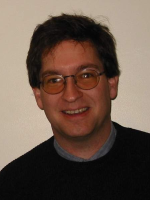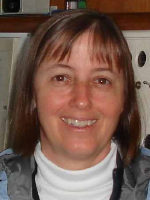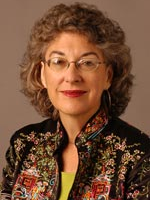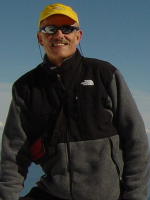Allan J. Rossman, Cal Poly - San Luis Obispo
"Seven Challenges for the Undergraduate Statistics Curriculum in 2007"
Abstract
I pose seven questions concerning the undergraduate curriculum in statistics. I offer some observations, and perhaps some data, on the current state of these issues. I also identify some recent efforts to address these questions, cite some challenges that could impede progress, and propose some recommendations.
The questions are:
- How does quantitative literacy fit in?
- Do we really need umpteen flavors of introductory courses?
- Should we re-center the Stat 101 universe?
- How do we deal with success in Stat 101?
- Have we forgotten about math and stat majors?
- How should we prepare future teachers?
- What do we want statistics majors/minors/concentrators to know?
About the speaker
 Allan J. Rossman is a Professor in the Department of Statistics at Cal Poly in San Luis Obispo. His work has focused on developing curricular materials to support active learning approaches to teaching introductory statistics. With Beth Chance, he is co-author of the Workshop Statistics series of coursebooks and also of Investigating Statistical Concepts, Applications, and Methods. He and Dr. Chance have also co-edited STATS magazine and the Proceedings of the Seventh International Conference on Teaching Statistics. Dr. Rossman has chaired the ASA's Section on Statistical Education and the ASA/MAA Joint Committee on Undergraduate Statistics. He is currently President-Elect of the International Association for Statistical Education and is the 2007 Program Chair for the Joint Statistical Meetings. Dr. Rossman was selected as a Fellow of the ASA in 2001.
Allan J. Rossman is a Professor in the Department of Statistics at Cal Poly in San Luis Obispo. His work has focused on developing curricular materials to support active learning approaches to teaching introductory statistics. With Beth Chance, he is co-author of the Workshop Statistics series of coursebooks and also of Investigating Statistical Concepts, Applications, and Methods. He and Dr. Chance have also co-edited STATS magazine and the Proceedings of the Seventh International Conference on Teaching Statistics. Dr. Rossman has chaired the ASA's Section on Statistical Education and the ASA/MAA Joint Committee on Undergraduate Statistics. He is currently President-Elect of the International Association for Statistical Education and is the 2007 Program Chair for the Joint Statistical Meetings. Dr. Rossman was selected as a Fellow of the ASA in 2001.
Jessica Utts, University of California at Davis
"Recognizing and Valuing Variability - In Our Students and Ourselves"
Abstract
When asked what the most fundamental concept is in Statistics many teachers would respond that it is "variability." Measuring and predicting variability is what Statistics is all about. Yet, we often don't recognize variability in the very place where it matters most! When we discuss "the best way to teach Statistics" it implies that there is one way that is best for all students to learn and all teachers to teach. But students have a wide range of learning styles, and what works well for some students is completely inappropriate for others. We have all observed in ourselves and our colleagues that what works well for some teachers does not work for others. In short, we preach variability but often we don't teach as if it exists. In this talk I will discuss student and teacher variability and how we might incorporate them into teaching Statistics.
About the speaker
 Jessica Utts is a Professor of Statistics at the University of California at Davis. She is the author of Seeing Through Statistics (3rd edition, 2005) and the co-author with Robert Heckard of Mind On Statistics (3rd edition, 2006) and Statistical Ideas and Methods (2006), all published by Duxbury Press. Jessica has been active in the statistics education community at the high school and college level. For six years she served as a member of the Advanced Placement Statistics Development Committee, half of that time as Chair. She is the 2006 Chair-Elect and 2007 Chair of the ASA Section on Statistical Education and served on the ASA GAISE College Report panel. She is the recipient of the Academic Senate Distinguished Teaching Award and the Magnar Ronning Award for Teaching Excellence, both at the University of California, Davis. She is a Fellow of the American Statistical Association, the Institute of Mathematical Statistics and the American Association for the Advancement of Science. Beyond statistics education Jessica's major contributions have been in applying statistics to a variety of disciplines, most notably to parapsychology, the laboratory study of psychic phenomena. She has appeared on numerous television shows, including Larry King Live, ABC Nightline, CNN Morning News and 20/20, and in a documentary included on the DVD with the movie "Suspect Zero."
Jessica Utts is a Professor of Statistics at the University of California at Davis. She is the author of Seeing Through Statistics (3rd edition, 2005) and the co-author with Robert Heckard of Mind On Statistics (3rd edition, 2006) and Statistical Ideas and Methods (2006), all published by Duxbury Press. Jessica has been active in the statistics education community at the high school and college level. For six years she served as a member of the Advanced Placement Statistics Development Committee, half of that time as Chair. She is the 2006 Chair-Elect and 2007 Chair of the ASA Section on Statistical Education and served on the ASA GAISE College Report panel. She is the recipient of the Academic Senate Distinguished Teaching Award and the Magnar Ronning Award for Teaching Excellence, both at the University of California, Davis. She is a Fellow of the American Statistical Association, the Institute of Mathematical Statistics and the American Association for the Advancement of Science. Beyond statistics education Jessica's major contributions have been in applying statistics to a variety of disciplines, most notably to parapsychology, the laboratory study of psychic phenomena. She has appeared on numerous television shows, including Larry King Live, ABC Nightline, CNN Morning News and 20/20, and in a documentary included on the DVD with the movie "Suspect Zero."
Joan Garfield, University of Minnesota
"Collaboration in statistics education research: stories, reflections, and lessons learned"
Abstract
This presentation summarizes 25 years of research on teaching and learning statistics. This is done through stories of research projects I have been involved in, all of which involved collaborations with colleagues who have made important contributions to the research and from whom I have learned many important lessons. I discuss these projects in terms of the research questions addressed, the methodologies used, the results and implications, and the importance of my collaborators in each project.
About the speaker
 Joan Garfield is a professor of Educational Psychology at the University of Minnesota, where she runs a unique graduate program in statistics education and teaches courses on teaching statistics and research in statistics education. She is Associate Director of CAUSE heading the research arm of the consortium. She is an active participant in national and international organizations involving statistics education and is an Associate Editor for the IASE Statistics Education Research Journal. She serves as Vice-Chair for the United States Commission on Mathematics Instruction, is an ASA Fellow and recipient of the ASA Founder's award and currently co-directs (with Bob delMas) two NSF grants (ARTIST and AIMS).
Joan Garfield is a professor of Educational Psychology at the University of Minnesota, where she runs a unique graduate program in statistics education and teaches courses on teaching statistics and research in statistics education. She is Associate Director of CAUSE heading the research arm of the consortium. She is an active participant in national and international organizations involving statistics education and is an Associate Editor for the IASE Statistics Education Research Journal. She serves as Vice-Chair for the United States Commission on Mathematics Instruction, is an ASA Fellow and recipient of the ASA Founder's award and currently co-directs (with Bob delMas) two NSF grants (ARTIST and AIMS).
Dick De Veaux, Williams College
"Math is Music: Statistics is Literature"
Abstract
Gauss could add up hundreds of numbers in his head by the age of 3 and Mozart was playing the pieces he'd heard in church at home by about the same age. But who ever heard of a literary prodigy? Why not? Because literature is about the world and the wisdom one gains with experience, not about abstract rules and symbols. The same is true of Statistics. Rather than highlight the formulas that underlie Statistics, we need to emphasize the learning that Statistics gives us about the world. The most common mistakes in Statistics have nothing to do with calculation but everything to do with interpretation and context. How can we help students to use statistical thinking effectively in the chaotic maze of the real world?
About the speaker
 Dick De Veaux is Professor of Statistics at Williams College, but for the academic year 2006/7 he will be the Kenan Visiting Professor for Distinguished Teaching at Princeton University. The previous year he was an invited professor at the Université Réné Descartes in Paris (Medical School). He holds degrees in Civil Engineering (B.S.E. Princeton), Mathematics (A.B. Princeton), Dance Education (M.A. Stanford) and Statistics (Ph.D., Stanford). He was also an Assistant Professor at the Wharton School and Princeton. He has won numerous teaching awards including a "Lifetime Award for Dedication and Excellence in Teaching" from the Engineering Council at Princeton. He has won both the Wilcoxon and Shewell awards from the American Society for Quality and was elected a fellow of the ASA in 1998. Dick has been a consultant for over 20 years for such Fortune 500 companies as Hewlett-Packard, Alcoa, American Express, Bank One, GlaxoSmithKline, Dupont, Pillsbury, Rohm and Haas, Ernst and Young, and General Electric. He holds two U.S. patents and is the author of over 30 refereed journal articles. He is the co-author, with Paul Velleman and David Bock, of the textbooks "Intro Stats", "Stats: Modeling the World" and "Stats: Data and Models" all published by Addison-Wesley. His hobbies include cycling, swimming, singing (barbershop, doo wop and classical) -- and dancing (he was once a professional dancer and teaches Modern Dance during Winter Study at Williams). He is the father of two boys and two girls aged 17, 15, 13 and 11.
Dick De Veaux is Professor of Statistics at Williams College, but for the academic year 2006/7 he will be the Kenan Visiting Professor for Distinguished Teaching at Princeton University. The previous year he was an invited professor at the Université Réné Descartes in Paris (Medical School). He holds degrees in Civil Engineering (B.S.E. Princeton), Mathematics (A.B. Princeton), Dance Education (M.A. Stanford) and Statistics (Ph.D., Stanford). He was also an Assistant Professor at the Wharton School and Princeton. He has won numerous teaching awards including a "Lifetime Award for Dedication and Excellence in Teaching" from the Engineering Council at Princeton. He has won both the Wilcoxon and Shewell awards from the American Society for Quality and was elected a fellow of the ASA in 1998. Dick has been a consultant for over 20 years for such Fortune 500 companies as Hewlett-Packard, Alcoa, American Express, Bank One, GlaxoSmithKline, Dupont, Pillsbury, Rohm and Haas, Ernst and Young, and General Electric. He holds two U.S. patents and is the author of over 30 refereed journal articles. He is the co-author, with Paul Velleman and David Bock, of the textbooks "Intro Stats", "Stats: Modeling the World" and "Stats: Data and Models" all published by Addison-Wesley. His hobbies include cycling, swimming, singing (barbershop, doo wop and classical) -- and dancing (he was once a professional dancer and teaches Modern Dance during Winter Study at Williams). He is the father of two boys and two girls aged 17, 15, 13 and 11.
J. Michael Shaughnessy, Portland State University
"Research in Statistics Education: Current Themes, Telling Tasks, Future Recommendations"
Abstract
Over the past fifteen years there has been so much growth in research in Statistics Education throughout both the national and international statistics and mathematics education communities that it has become impossible for anyone to keep up on it all. Yet, that is exactly what I was asked to try to do in a recent review, analysis, and synthesis of research in statistics education, published by the National Council of Teachers of Mathematics. Most of the research in statistics education has concentrated on students' statistical reasoning and learning, at all levels, elementary through tertiary. Although there has been some research on teachers' knowledge of statistics, and teaching practices in statistics, the bulk of research has concentrated on students' understandings of some big ideas in statistics, such as centers, variation, comparison of data sets, and samples and sampling.
This talk will focus on a few of the themes that have arisen during the past several decades of research on student reasoning in statistics. Often the story that emerges about students' statistical reasoning is encapsulated from responses to what I call "Telling Tasks." These are tasks that are particularly helpful in shedding light on the variety of ways that students can and do reason about big ideas in statistics, such as centers, variation, sampling, and data sets in general. Examples of tasks, as well as student responses to these tasks, will be shared throughout the talk. This research review process also uncovered some possible suggestions for future research, and some implications for the teaching of statistics, which will be included in the discussion.
About the speaker
 Mike Shaughnessy is the director of the doctoral program in mathematics education in the Department of Mathematics and Statistics at Portland State University, and is also currently the director of a four-year NSF ROLE project to investigate middle and secondary students' conceptions of variability and distribution in statistics. He has served as a member of the Board of Directors of the National Council of Teachers of Mathematics (2001 to 2004), and is beginning the second year of a two-year term on the Board of the Special Interest Group for Research in Mathematics Education (SIG/RME). Throughout his career, Dr. Shaughnessy's principal research interests have been in the teaching and learning of statistics and probability (stochastics), and the teaching and learning of geometry. He has worked in the area of students' understanding of chance and data since his graduate student days, and has attempted to synthesize and build on the contributions of psychologists and math/stat educators alike to our understanding of student learning in stochastics (data and chance), particularly in his 1992 chapter Probability and Statistics: Reflections and Directions which appeared in the first edition of the Handbook of Research on Mathematics Teaching and Learning. His current writing projects include a chapter on research in statistics in the forthcoming second edition of the Handbook of Research in Mathematics Teaching and Learning (Infoage Pubs), as well as a forthcoming chapter on the 2000 and 2003 NAEP results from Grades 4 and 8 in probability and statistics (NCTM). In his work in probability and statistics, Dr. Shaughnessy has collaborated on research projects and papers with Jane Watson, Maxine Pfannkuch, Chris Reading, and James Tarr, among other statistics educators.
Mike Shaughnessy is the director of the doctoral program in mathematics education in the Department of Mathematics and Statistics at Portland State University, and is also currently the director of a four-year NSF ROLE project to investigate middle and secondary students' conceptions of variability and distribution in statistics. He has served as a member of the Board of Directors of the National Council of Teachers of Mathematics (2001 to 2004), and is beginning the second year of a two-year term on the Board of the Special Interest Group for Research in Mathematics Education (SIG/RME). Throughout his career, Dr. Shaughnessy's principal research interests have been in the teaching and learning of statistics and probability (stochastics), and the teaching and learning of geometry. He has worked in the area of students' understanding of chance and data since his graduate student days, and has attempted to synthesize and build on the contributions of psychologists and math/stat educators alike to our understanding of student learning in stochastics (data and chance), particularly in his 1992 chapter Probability and Statistics: Reflections and Directions which appeared in the first edition of the Handbook of Research on Mathematics Teaching and Learning. His current writing projects include a chapter on research in statistics in the forthcoming second edition of the Handbook of Research in Mathematics Teaching and Learning (Infoage Pubs), as well as a forthcoming chapter on the 2000 and 2003 NAEP results from Grades 4 and 8 in probability and statistics (NCTM). In his work in probability and statistics, Dr. Shaughnessy has collaborated on research projects and papers with Jane Watson, Maxine Pfannkuch, Chris Reading, and James Tarr, among other statistics educators.
Paul F. Velleman, Cornell University
"Truth, Damn Truth, and Statistics"
Abstract
Statisticians and Statistics teachers often have to push back against the popular impression that Statistics teaches how to lie with data. Those who believe incorrectly that Statistics is a branch of Mathematics (and thus algorithmic) often see the use of judgment in Statistics as evidence that we do indeed manipulate our results.
In the push to teach formulas and definitions, we may fail to emphasize to students the important role played by judgment. We should teach our students that they are personally responsible for the judgments they make. But we must also offer guidance for their statistical judgments. The principle guiding these judgments should be the honest search for truth about the world, and the principle of seeking such truth should have a central place in Statistics courses.
About the speaker
 Paul Velleman has an international reputation for innovative Statistics education. He is the author and designer of the multimedia statistics CD-ROM, ActivStats, for which he was awarded the EDUCOM Medal for innovative uses of computer in teaching statistics, and the ICTCM Award for Innovation in Using Technology in College Mathematics. He also developed the statistics program, Data Desk and the Internet site Data and Story Library (DASL) (lib.stat.cmu.edu/DASL/), which provides datasets for teaching statistics.
Paul Velleman has an international reputation for innovative Statistics education. He is the author and designer of the multimedia statistics CD-ROM, ActivStats, for which he was awarded the EDUCOM Medal for innovative uses of computer in teaching statistics, and the ICTCM Award for Innovation in Using Technology in College Mathematics. He also developed the statistics program, Data Desk and the Internet site Data and Story Library (DASL) (lib.stat.cmu.edu/DASL/), which provides datasets for teaching statistics.
He is co-author (with Richard De Veaux and David Bock) of the books ABCs of Exploratory Data Analysis (with David Hoaglin), Intro Stats, Stats: Modeling the World, and Stats: Data and Models.
Paul has taught Statistics at Cornell University since 1975. He is a Fellow of the American Statistical Association and of the American Association for the Advancement of Science.
